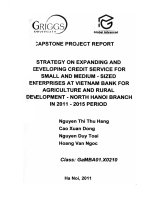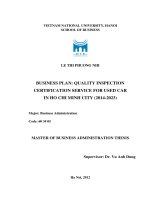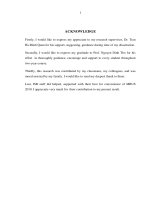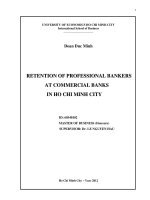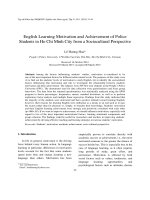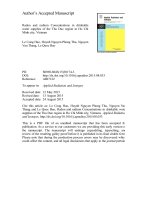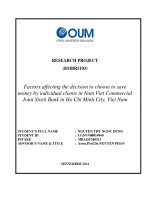Knowledge sharing intention among employees in small and medium sized enterprises: a case in Ho Chi Minh City Viet Nam
Bạn đang xem bản rút gọn của tài liệu. Xem và tải ngay bản đầy đủ của tài liệu tại đây (1.05 MB, 79 trang )
UNIVERSITY OF ECONOMICS HO CHI MINH CITY
International School of Business
------------------------------
Ta Tran Trung
KNOWLEDGE SHARING INTENTION AMONG
EMPLOYEES IN SMALL AND MEDIUM SIZED
ENTERPRISES: A CASE IN HO CHI MINH CITY,
VIETNAM
MASTER OF BUSINESS ADMINISTRATION
Ho Chi Minh City – Year 2018
1
UNIVERSITY OF ECONOMICS HO CHI MINH CITY
International School of Business
------------------------------
Ta Tran Trung
KNOWLEDGE SHARING INTENTION AMONG
EMPLOYEES IN SMALL AND MEDIUM SIZED
ENTERPRISES: A CASE IN HO CHI MINH CITY,
VIETNAM
MASTER OF BUSINESS ADMINISTRATION
SUPERVISOR: Dr. TRAN PHUONG THAO
Ho Chi Minh City – Year 2018
2
ACKNOWLEDGEMENT
I would like to express my deep gratitude to my supervisor, Dr. Tran Phuong Thao
for het patient attitude, valuable comment, helpful advice and continuous encouragement
during the time of research and writing this research work.
My grateful thanks are also extended to my friends, my lecturers and Research
Committee for their valuable time as their insightful comments and meaningful
suggestions were contributed significantly for my completion of this research.
3
LIST OF ABBREVIATION WORDS
CEO: Chief Executive Officer
CFA: Confirmatory Factor Analysis EFA Exploratory Factor Analysis
GDP: Gross Domestic Product
ITC: Information and communication technology
SEM: Structural Equation Modeling
SMEs: Small and medium sized enterprises
TRA: The Theory of Reasoned Action
VND: Vietnamese Dong
4
LIST OF TABLES
Table 1 A summary of prior studies on knowledge sharing ........................................... 16
Table 2 Measurement Scale ............................................................................................ 19
Table 3 Descriptive statistics ........................................................................................... 21
Table 4 Means and Cronbach alpha of items after deleting items results ....................... 25
Table 5 Pattern matrix ..................................................................................................... 27
Table 6 KMO and Bartlett's Test..................................................................................... 28
Table 7 SEM Hypothesis testing results ......................................................................... 32
Table 8 Multi-group analysis results ............................................................................... 34
LIST OF FIGURES
Figure 1. Conceptual model ............................................................................................... 17
Figure 2. CFA model ......................................................................................................... 29
Figure 3. SEM Results ....................................................................................................... 31
Figure 4. Multi-group analysis model ............................................................................... 33
5
TABLE OF CONTENTS
1. Introduction ................................................................................................................................ 2
2. Literature review and hypothesis development.......................................................................... 6
2.1. Foundational theory ............................................................................................................ 6
Social Exchange Theory ............................................................................................................. 6
Theory of Reasoned Action ......................................................................................................... 8
2.2. Related review and hypothesis ............................................................................................ 9
3. Research methodology ............................................................................................................. 17
3.1. Research procedure ........................................................................................................... 17
3.2. Measurements ................................................................................................................... 18
3.3. Sampling and methods ...................................................................................................... 20
3.3.1
Sampling .................................................................................................................. 20
3.3.2
Methods ................................................................................................................... 22
4. Data analysis and results .......................................................................................................... 23
4.1. Reliability analysis ............................................................................................................ 23
4.2. Exploratory Factor Analysis ............................................................................................. 26
4.3. Confirmatory Factor Analysis ........................................................................................... 28
4.4. SEM modeling .................................................................................................................. 30
4.5. Hypothesis testing ............................................................................................................. 31
4.6. Multi-group analysis results (The moderating effect results) ........................................... 32
5. Conclusions and implications .................................................................................................. 35
5.1. Conclusions ....................................................................................................................... 35
5.2. Implications ....................................................................................................................... 35
5.3. Limitations and directions for future research .................................................................. 38
References ..................................................................................................................................... 40
Appendix 1.
Questionnaire English version ............................................................................ 49
Appendix 2.
Bảng câu hỏi khảo sát (Questionnaire Vietnamese version) ............................... 53
Appendix 3.
Cronbach’s alpha results ..................................................................................... 57
Appendix 4.
EFA results .......................................................................................................... 59
KMO and Bartlett's Test ............................................................................................................... 59
Appendix 5.
CFA results .......................................................................................................... 62
Appendix 6.
SEM results ......................................................................................................... 66
Appendix 7.
Multi-group analysis results ................................................................................ 70
6
Abstract
Knowledge is a valuable asset, a creativity, innovation, and potential contribution for the
development of business. That is the reason why knowledge sharing is researched to find
out the way to promote knowledge sharing, to take advantage of this core competency.
A survey with a convenience sample of about 450 SMEs employees in Ho Chi Minh City
was conducted with 18 variables and 429 observations valid samples in order to assess an
overview of the opinions of all employees in SMEs on intend to share knowledge. The
data were analyzed by Reliability Analysis, EFA, CFA, SEM method and the results
indicated factors Image, Subjective norms and Rewards have positive influence on the
intention to share knowledge and Individual culture has a significant moderating effect on
the relationship between both Image and Subjective norms toward intention to share
knowledge. Based on the finding of the research, the organization should respect and
listen to the opinions of the employees and create the awareness of knowledge sharing as
a must. As majority of prior researches on enterprise knowledge sharing focus mainly on
the public sector, large private companies, these new findings can be investigated in
further research, because sharing knowledge in SMEs is still a new concept in developing
country as Vietnam.
Keywords
knowledge sharing intention, small and medium sized enterprises, Subjective norms,
Image, Rewards, Intention to share knowledge, Individual culture.
1
1. Introduction
Managing knowledge effectively is believed to be crucial to the achievement of the
organization, specifically in those companies that want to maintain their dominance
through creativity (Dieng, 2000). As more companies try to increase benefit by widen
their knowledge assets, a lot of enterprises have considered knowledge sharing as part of
their strategy. It is believed that knowledge sharing has been concerned by many
academics and professionals globally. Zakaria, Amelinckx and Wilemon (2004) confirm
that the role of knowledge sharing within a team should be emphasized. Blair (2002)
believes that when employees in the organization gain a lot of knowledge in their
organization, the organization has something far more valuable than data and
information.
Many prior studies show that collaboration and knowledge sharing are important factors
that organization should applied so as to attain continued competitive advantage
(Tapscott & Williams, 2006). Cyril Eze, Guan Gan Goh, Yih Goh and Ling Tan (2013)
state that a number of SMEs are manipulate knowledge management program to keep up
with or stay ahead of their competitors as a business leader.
In Vietnamese organizations, it is easy to see that the tendency to approach new things in
knowledge has evolved since the "Doi Moi" era to adapt to the globalized economy.
Although the sharing of knowledge is often seen as something new and meaningful in the
context of Vietnam (Dong, Gia Liem, & Grossman, 2010), Dong et al., (2010) reveal that
this is in fact only strongly empower individuals to access organizational knowledge
2
instead of sharing their knowledge to other members. Beside the practicality of
knowledge sharing in companies, there are existing elements restraint knowledge sharing
culture, including the lack of organizational structures, unfriendly sharing working
environment, and denominational segregation (Davenport & Prusak, 1998; as cited in
Hendriks, 1999). Additionally, the fact is that SME enterprises occupy most of the
companies in Vietnam and contribute most of the domestic work (Swierczek & Ha, 2003;
Dan, 2008). In general, the ineffective knowledge sharing system can make employees in
a company unable to improve their knowledge and transfer their experience to other
members. On the other hand, a rich and effective knowledge sharing system can help
employees save time and effort to solve problems that arise in the workplace.
Witherspoon, Bergner, Cockrell and Stone (2013) believe that the future success of the
organization will depend on sharing knowledge and this will be a vital strategy in the new
era. It is understood that an organization will create a better working environment for
development and innovation as it builds a better and more effective knowledge sharing
system. In addition, Desouza and Awazu (2006) state that common knowledge of
employees of SMEs is deep and broad, and it can actively support small business in
knowledge sharing. Prior studies also indicate some of the factors that impact the
knowledge sharing intension such as company rewards, reciprocity, ICT use, knowledge
self-efficacy and top management support (Chang, Hsu, Shiau, & Tsai, 2015; Dong et al.,
2010; Kanzler, Niedergassel, & Leker, 2012; Tohidinia & Mosakhani, 2010). However,
as given by Tohidinia and Mosakhani (2010) almost studies take into account
3
determinants of knowledge sharing intention in a specific group of people or a whole
population. Notably, studies by Fathi, Eze and Goh (2011) and also Chong, Chong and
Wong (2007) indicate that the majority of prior researches on enterprise knowledge
sharing focus on the public sector, large private companies, while very few focus on
knowledge management conducted in SMEs. Additionally, according to Yu (2014),
individual culture in different countries may affect the knowledge sharing intention, but
there are not many studies investigating the influence of this factor on knowledge sharing
intention. In SMEs the knowledge management model which is basically based upon
knowledge sharing – through constant and open communication (often SME strength) –
the making explicit of often buried or tacit knowledge held by all employees (Gray,
2006). Gold, Malhotra and Segars (2001) emphasize that knowledge infrastructures such
as technology, structure and culture along with knowledge acquisition, conversion,
application and protection are essential organizational capabilities for higher
organizational performance. Therefore, SMEs need to identify the influence of personal
culture on the sharing of knowledge to bring more valuable benefits to their organization.
It is believed that large firm with large customer base tent to perceive a Knowledge
management system more useful and have a better chance to apply Knowledge
management system to build sustain competitive advantage. Besides, SMEs are known of
lacking of knowledge management practices even though they have a strong
communication links and social networks in the organization. It is said that knowledge
sharing especially tacit knowledge, is highly and actively interacted in SMEs. As more
4
and more researches are interested in exploring this tacit knowledge sharing which is
very valuable and difficult to codify, SMEs could benefit from this advantage compared
to bigger organizations.
While there are many documents indicate some examples of research related to
knowledge sharing, previous studies show that there is not much study on the intention to
share knowledge in developing economies like Vietnam. With a relatively large
population, Vietnam has a thriving economy, always focused on strengthening global
trade relations. With these factors, the economy is considered as the most remarkable
economy in Southeast Asia (Doan Ngoc & Nguyen, 2013). With these factors, the
economy is considered as the most remarkable economy in Southeast Asia (Doan Ngoc
& Nguyen, 2013). The role of SMEs in Vietnam is widely accepted as the main driving
force for the national economy (Molnar, Nguyen, Homolka, & Macdonald, 2011).
According to statistics from the Ministry of Justice, there is a strong growth of
Vietnamese SMEs over the past few years, accounting for 97% of the total number of
domestic enterprises. In addition, there are many important roles and benefits of SMEs,
such as creating jobs, increasing income for workers, encouraging social capital for
investment and development, reducing poverty in the local area. SMEs generate more
than half of new jobs; using up to 51% of the workforce and contributing up to 40% of
GDP (Phan, Nguyen, Mai, & Le, 2015). Therefore, by investigating the importance of
knowledge sharing for SMEs in Vietnam, the study could help to improve the knowledge
5
sharing culture of SMEs, thereby contributing significantly to the development of
business in Vietnam.
Dong et al. (2010) argues that Vietnam is still at the beginning of its own preparations for
full participation in the knowledge economy. Even though a lot of research papers have
been implemented to produce research on knowledge management and innovation
strategies, research based on the context of the Asia Pacific region is still in the
development stage. Additionally, as argue by Dong et al. (2010), many prior studies take
into account large companies instead of SMEs. Thus, the findings of this study could be
embedded in Vietnamese contexts to find the practical ways for enterprises to implement
successfully and fill the gap of studying the moderating role of individual culture in the
relationship between factors and knowledge sharing intention in order to contribute to the
development of SMEs in Vietnam.
2. Literature review and hypothesis development
2.1. Foundational theory
Social Exchange Theory
Social exchange theory is a social psychological and sociological perspective that
describes social change and stability as a process of negotiated exchanges between
parties. Social exchange theory posits that human relationships are formed by the use of a
subjective cost-benefit analysis and the comparison of alternatives. In other words, this
theory believe that people rely on the costs and benefits related to forming relationships,
6
rather than just relying on emotions. It is applicable not only in the relationship between
individuals together, but also be applied in the relationship between colleagues at work
and other relationships
George and Homans (1961) develope Social exchange theory. They demonstrate that
interactive behavior of human beings are shaped by awareness of the benefits and costs,
and also introduced the concept of psychology as well as the proposed reward society.
The theory of social exchange suggests that people interact with others based on their
self-interest assessment of the costs and benefits of those interactions. Generally, people
always not only seek to increase their benefits but also decrease their costs when using
their limited resources or interacting with others. The cost here is something that is
considered negative to an individual such as the use of limited resources such as time,
money and effort into a relationship. For example, if a friend has a habit of borrowing
money, maintaining a relationship with him or her is considered a relatively high cost.
This theory is considered to be an extremely important document in the interpretation and
prediction of social behavior and built on the concept that people share their information
and knowing with those who have a give and take relationship rather than relying on
incentives. Based on the idea that knowledge sharing is a shape of social exchange, some
previous research use this idea to analyze as well as forecast the intention to share
knowledge (Bock, Zmud, Kim, & Lee, 2005; Kankanhalli, Tan, & Wei, 2005). Constant,
Kiesler and Sproull (1994) show that although individuals tend to exchange their
knowledge spontaneously, they are unlikely to exchange their knowledge if they feel that
the asker are not useful to them. In other words, people will be more willing in sharing
7
knowledge when they predict a mutual relationship that will shape with the requester.
This is a mutually beneficial relationship.
Theory of Reasoned Action
The Theory of Reasoned Action are considered pioneering in the field of psychosocial
research (Fishbein & Ajzen, 1977). This theoretical model shows that behavior is decided
by the intention to achieve that behaviour. In the development of the theory of reasoned
action, Fishbeint instead analyzes attitudes toward an object, then analyzes attitudes
toward a behavior related to that object. For example, while most theorists have measured
attitudes towards a book in trying to predict reading behavior, Fishbein demonstrate that
measuring attitudes toward reading behavior will make better forecasts (compared to
measuring attitudes toward books) on reading behavior.
Theory of reasoned action supposes that humans are born rational and convince that the
way people behave is decided by 3 factorials: attitude toward the behaviour, subjective
norms and behavior intention. According to theory of reasoned action, the mindset of a
person towards a behaviour is decided by his attitudes about the outcomes of this
behaviour. This theory is applied to social psychology to describe human behavior and it
has been used in many fields of study including psychology, management and marketing.
The theory of reasoned action is applied in many research as a model for testing many
types of behaviors like behavioral communication, consumer behaviour, and health
behaviour. Shimp and Kavas (1984) apply this theory to the study of the use of coupons
by consumers. Bock et al. (2005) claim that extrinsic motivators, social psychologycal
forces and organizational environment factors could impact knowledge sharing
8
intentions. Ho, Hsu and Oh (2009) use this theory to study behavioral communication in
the organization. The result is that the more indirect decisions that are made in the
organization, the more ineffective the sharing of knowledge, and to encourage knowledge
sharing, corporate managers should avoid indirect decisions.
2.2. Related review and hypothesis
Knowledge sharing intention
Knowledge is a flexible concept, which is difficult to describe by range or visibility.
Although there are many different expressions, there is a strong consensus among
scholars and specialists that knowledge is an essential element in helping organizations
achieve success. Knowledge is debatably one of the most vital factors leading innovation
in modern economy today (Grant, 1996; Stewart, 1997). Although knowledge is useful
for personal understanding, it will also be helpful to others when it is shared. According
to Kumar and Raduan (2012) knowledge sharing can define as a social interaction
culture, involving the exchange of woker expertise, acquirements and skills across the
company. Knowledge sharing takes place when organizational colleagues share material,
thoughts, proposals and knowledge related to organizations together (Bartol &
Srivastava, 2002).
Organizational culture is a field that is clearly expressed in knowledge sharing literature
(Al-Alawi, Al-Marzooqi, & Mohammed, 2007). One critical side of knowledge sharing is
culture, defined as “the sum of the values, rituals, symbols, beliefs, and thought processes
that are learned, shared by a group of people, and transmitted from generation to
9
generation” (Cateora & Graham, 2007). Many prior studies examine factors influencing
Knowledge sharing. Among these factors, several are selected to examine are as below.
Subjective norm
Azjen and Fishbein, the inventers of the theory of reasoned action, state subjective norms
is a collection perceived prospects from related individuals or groups along with
intentions to comply with these forecast. Perceived subjective norms are a critical factor
that can impact intention toward a particular behavior (Tohidinia & Mosakhani, 2010). In
general, people tend to do something when they actively evaluate the behavior and when
they think that others think they should do it (Celuch & Dill, 2011). Kuo and Young
(2008) suggest that beside attitude, compatibility and self-efficacy, subjective norms
somewhat described the individual’s knowledge sharing intentions.
Some researchers show that the better the subjective norms to share knowledge is, the
better the knowledge sharing intention will be (Bock et al., 2005). As people want to be
recognized and famouse by other people, understanded subjective norms is important to
develope their intention to share knowledge (Sun & Scott, 2005). Vietnamese employees
in SMEs are not exceptional. Further, Vietnamese employees in SMEs usually appreciate
harmony, loyalty and are oriented towards collectivism and long standing affected by
Confucian values and ideals. Generally people with more collective-orientation are more
happly to be allocated and dedicate to their organization. Consequently, they are more
willing to share their experiences with others to enable the development of their
organization. One person’s collectivism is found by Hwang and Kim (2007) to be
supportively related to his attitude toward using the group email function in an online
10
classroom management system to share knowledge. Accordingly, one hypothesis is
suggested as follow:
Hypothesis H1: Subjective norm has a positive influence on Intention to share
knowledge among employees in SMEs
Image
Generally, reputation is more and more significant. People desire to build their image as
professionals in an enterprise (Huang, Davison, & Jibao, 2008). One solution to build
their image is to share their experience and information with their colleagues. Obviously,
people will gain respect and reputation when they share useful knowledge (Constant et
al., 1994). Being more renowned by colleagues is a good chance for them to enhance
their career.
People believe that they can improve their social position and their image when sharing
knowlegde (Hsu & Lin, 2008). Knowledge allows workers to be recognized and
appreciated by their superiors. It enhances the staff’s respectability and image
(Kankanhalli et al., 2005). Studies by Huang et al. (2008) and Kankanhalli et al. (2005)
find that image and knowledge sharing behavior have a definite relation.
Since Vietnamese employee is collectivism, they really care for what people talk about
them (Chang et al., 2015). Hsu and Lin (2008) recommend that the more respectation or a
better image through knowledge sharing that employees could earn, the more willingness
they share. Besides, SMEs employees are young and they want build a solid foundation
for their professional image and personal brand. By sharing knowledge at their
11
workplace, they can build good reputation and personal image, especially when media
being an ubiquitous part of our lives. Accordingly, one hypothesis is suggested as follow:
Hypothesis H2: Image has a positive influence on Intention to share knowledge among
employees in SMEs
Reward
Researchers define organizational rewards as both financial and non-financial benefits
that a worker achieves while working in an company (Malhotra, Budhwar, & Prowse,
2007). The prior researches classified 3 specific kinds of rewards that an employee looks
for from their company: extrinsic rewards, intrinsic rewards and social rewards
(Williamson, Burnett, & Bartol, 2009). More specifically, extrinsic rewards are suggested
by the organization from out-of-job content while in the other hand, intrinsic rewards are
offered by the organization from on-job content and results to employee’s development
(Williamson et al., 2009). Social rewards come from the connection with other colleagues
on the job.
The social-exchange perspective debates that people evaluate the overall value of a
specific relationship by subtracting its costs from the rewards it provides “Worth =
Rewards – Costs”. If the answer is greater than zero, it is a positive relationship. On the
contrary, a lower than zero answer indicates a negative relationship. The value of a
relationship affects its outcome, or whether people will endure with a relationship or put
an end to it. Positive relationships are predictable to exist, whereas negative one will
possibly end. This research therefore anticipate that when employees understand that they
12
can earn more rewards by sharing their knowledge, they would provide a better
willingness to contribute and obtain knowledge.
People believe that having rewards when sharing knowledge is important (Kankanhalli et
al., 2005). Riege (2005) believes that lacking strong reward and recognition systems may
discourage workers to share their knowledge. On the other hand, an organization should
create an appropriate knowledge sharing encouragement system to support knowledge
contribution of organizational members (Chua, 2003). Both intrinsic and extrinsic
rewards are persistently described to be efficient factors for workforces to share their
understandings (Abdullah, Hassim, & Chik, 2009). It is believed that SMEs employees
could be easily encouraged to share knowledge because of economic incentive, such as
increased earnings and they will increase their commitment to their organization.
Accordingly, one hypothesis is suggested as follow:
Hypothesis H3: Rewards have a positive impact on sharing knowledge intention among
employees in SMEs.
Individual culture
Despite from the same country, two individuals might have various cultural values (Lee,
Choi, Kim, & Hong, 2007). Gallivan and Srite (2005) prove that the ethnic background,
region, and society might influence the cultural values (Gallivan & Srite, 2005). Further,
many previous studies suggest that cultural values should be measured at the individual
level of analysis (Srite & Karahanna, 2005). Base on Hofstede’s four dimensions to
measure national cultures, Chang et al. (2015) indicate that the awareness of benefits and
risk costs relates to individualism or collectivism and uncertainty prevention when
13
sharing knowledge, when other extents are declined the willingness to share thinking,
feelings, and experiences. Hence, in this study, individual culture includes both
Individualism and Collectivism. Individualism represents a society in which the
connection among people are weak: a man is only try to take care of himself and his
family. In the other hand, Collectivism represents a society in which people from birth
are included in strong and cohesive groups. These groups are considered to protect them
continuously throughout the life of the members in exchange for their loyalty (Hofstede,
1991).
Previous studies indicate that individuals in different culture have different processes of
knowledge sharing (Ardichvili, Maurer, Li, Wentling, & Stuedemann, 2006; Zhang,
Ribiere, & Thippaya, 2008). More pariticularly, interpreting the self is emphasized by
collectivism as an extension of one’s in-group and selecting in-group goals over private
goals. Conversely, Individualism clarify them self as distinct from one’s in-group and
choosing to personal goals over in-group goals. Individuals high on collectivist
orientation prioritize collectives’ demands and interests and are more willing to share
what they know with their society even though they perceive that such sharing involves
individual cost, because collectives’ demands and interests are related to the in-group
members’ long-term and overall interests by the collectivists. Some researchers propose
to promote knowledge sharing in organizations through boosting employees’ collectivism
orientation (Hwang & Kim, 2007). The Vietnamese profile is one of collectivism, similar
to other Asian countries. Further, SMEs employees normally come from country side and
deeply and affected by values and ideals of Confucian. To deal with the existing
14
limitation, the prior studies investigate how Individual cultural diversity affects different
factors significant for sharing knowledge in SMEs (Kanzler et al., 2012). Accordingly,
three hypotheses are suggested as follow:
Hypothesis H4a: The higher the degree of Individual culture, the higher the effect of
Subjective Norms on Intention to share knowledge among employees in SMEs
Hypothesis H4b: The higher the degree of Individual culture, the higher the effect of
Image on the SME employee Intention of sharing knowledge among employees in SMEs
Hypothesis H4c: The higher the degree of Individual culture, the higher the effect of
Reward on the SME employee Intention to share knowledge among employe
15
Table 1
A summary of prior studies on knowledge sharing
Variables
Item
Code
References
Rewards
1. It is important to be promoted when I share my
knowledge.
2. It is important to get a better work assignment when I
share knowledge
3. It is important to get a higher salary when I share my
knowledge
4. It is important to get a higher bonus when I share my
knowledge
5. It is important to get more job security when I share
my knowledge
1. My CEO thinks that I should share my knowledge
with other members in the organization
2. My colleagues think that I should share my
knowledge with other members in the organization
3. My CEO thinks that I should share my knowledge
with other members in the organization
REW1
Kankanhalli et al.,
2005
Subjective
norms
Image
Knowledge
sharing
intension
Individual
culture
1. Sharing my knowledge improves my image within the
organization
2. People in the organization who share their knowledge
have more prestige than those who do not
3. Sharing my knowledge improves others recognition of
me.
4. When I share my knowledge, the people I work with
respect me.
5. When I share my knowledge, my superiors praise me.
1. I will share my knowledge on an ordinary basis in the
future
2. I will frequently share my knowledge in the future
3. I will strongly recommend others to share knowledge
1. Individual rewards are more significant than
organization welfare
2. Individual success is more significant than
organization success
3. Being independence is more significant than being
accepted as a member of an organization
16
REW2
REW3
REW4
REW5
SNO1
Bock et al., 2005
SNO2
SNO3
IMG1
Kankanhalli et al.,
2005
IMG2
IMG3
IMG4
IMG5
KSI1
Moon and Kim,
2001
KSI2
KSI3
ICU1
ICU2
ICU3
Yoon, 2009
Figure 1. Conceptual model
Based on the above discussion, a model is suggested as follow:
3. Research methodology
3.1. Research procedure
The thesis process covers several stages, including literature review, research design,
qualitative method, main survey and data analysis which illustrated in the below process.
Based on literature from previous research about the Knowledge sharing intention in
SMEs, we proposed six hypotheses. After that, we adjusted the model and chose the
initial the scale for questionnaire of the study. Through the previous relevant researches,
the questionnaire was built then running the pilot test for checking the efficiency and the
meaning of the questions. The pilot test was purposed to explore and define the relevant
items and building a completed questionnaire. Then, the in-depth interviews with 10
employees in was carried out after finishing the questionnaire to get the right items with
17
Vietnamese employees. Then, we checked the words used in the first measurement scales
and modify them to be more appropriate and easy understanding. Though the previous
literature included most of the measures of the constructs, this step is essential to make
them suitable and understandable in studying context. After the qualitative research, we
adjusted the questionnaire again to be more appropriate to Vietnam market and to
understand more easily. When we designed the questionnaire properly, the main
investigation was implemented widely by using convenience samples which collected
from employees in Ho Chi Minh city.
3.2. Measurements
In the questionnaire, existing scale items from prior studies are used. The five-item scale
by Kankanhalli et al. (2005) is employed to measure the factor Rewards. Then the threeitem scale by Bock et al. (2005) is employed to assess the factor Subjective norms, the
five-item scale by Kankanhalli et al. (2005) to assess the factor Image, the three-item
scale by Yoon (2009) to measure the moderator Individual culture and finally the threeitem scale by Moon and Kim (2001) to measure the Intention to share knowledge.
18
Table 2 Measurement Scale
Variables
Item
Code
References
Rewards
1. It is important to be promoted when I share my
knowledge.
2. It is important to get a better work assignment when I
share knowledge
3. It is important to get a higher salary when I share my
knowledge
4. It is important to get a higher bonus when I share my
knowledge
5. It is important to get more job security when I share
my knowledge
1. My CEO thinks that I should share my knowledge
with other members in the organization
2. My colleagues think that I should share my
knowledge with other members in the organization
3. My CEO thinks that I should share my knowledge
with other members in the organization
REW1
Kankanhalli et al.,
2005
Subjective
norms
Image
Knowledge
sharing
intension
Individual
culture
1. Sharing my knowledge improves my image within the
organization
2. People in the organization who share their knowledge
have more prestige than those who do not
3. Sharing my knowledge improves others recognition of
me.
4. When I share my knowledge, the people I work with
respect me.
5. When I share my knowledge, my superiors praise me.
1. I will share my knowledge on an ordinary basis in the
future
2. I will frequently share my knowledge in the future
3. I will strongly recommend others to share knowledge
1. Individual rewards are more significant than
organization welfare
2. Individual success is more significant than
organization success
3. Being independence is more significant than being
accepted as a member of an organization
19
REW2
REW3
REW4
REW5
SNO1
Bock et al., 2005
SNO2
SNO3
IMG1
Kankanhalli et al.,
2005
IMG2
IMG3
IMG4
IMG5
KSI1
Moon and Kim,
2001
KSI2
KSI3
ICU1
ICU2
ICU3
Yoon, 2009
